- Home
- Harlan Ellison
The City on the Edge of Forever Page 2
The City on the Edge of Forever Read online
Page 2
Yeah, yeah, I know: “You let yourself get talked into writing this book? Come on, Ellison! Who the hell’s supposed to believe that? Ain’t this the same world we went to bed in last night? Isn’t the reason for doing a Star Trek book of any kind—picayune biography, sharecropping derivative novel, moron quiz book, obsessional trivia book, adolescent episode guide—for the money? Follow the money? We’re not fools, Ellison! Yeah, we might swallow any crap the Paramount p.r. mill cares to throw out, and all preproduction inside-secrets desiderata, but we ain’t naive enough to believe you’re doing this book for any other reason than money.”
So okay, all right, all you little cynical television goobers, believe what the hell you choose. I say I was talked into doing this book, that left to my own devices I’d have spent my time on more worthwhile projects, and if I make money off this thing, well, since I’ve never seen more than a pittance from “The City on the Edge of Forever,” while every thug and studio putz and semiliterate bandwagon-jumper and merchandiser has grown fat as a maggot in a corpse off what I created, then you can chalk it up to achieving something not even close to balance in the Unjust Universe. But if you want the truth, here it is.
There is only one reason I’m doing this book:
FYODOR DOSTOEVSKY
“It is not at all to justify myself that I’ve been doing all this talking. …But no! That’s a lie! I precisely wanted to justify myself. I make this little note for myself, gentlemen. I don’t want to lie. I’ve given my word.”
—from NOTES FROM UNDERGROUND
For thirty years I’ve had to listen to others shoot off their faces about how they saved “City.” How they rewrote this and trimmed that and suffered oh so awfully with the irresponsible Ellison.[1] For thirty years I’ve slapped back only when they got me too angry to lay back…or when they got within arm’s reach. And now, with Shatner’s pinheaded memoir, and that laughable “biography” by David Alexander that tried to make Roddenberry look like fuckin’ Prometheus…well…I let myself get talked into doing the original, unexpurgated, you-read-it-and-judge-for-yourself teleplay, with additional material, and alternate versions and various treatments…and this is my final word on the matter. If it makes money, that’s terrific: I deserve it. (A lot more than the creeps who’ve fed off my work for three decades.) And if it doesn’t…yeah, well, what are the odds all the brain-damaged Trekkies wanted to hear the truth anyhow?
Here’s the way this Rosetta Stone will be revealed to you. The script you are about to read is the original version. It is not the teleplay as presented by NBC on April 6th, 1967. The episode of Star Trek broadcast on that evening was rewritten. Many times. Some of those times by me. Some of those times by others. For the first time in thirty years, right here in this book, you will discover—as I did only when preparing this manuscript—who it was that had a hand in the rewrites of my script besides Coon and Roddenberry and Carabatsos. You may be mildly startled to learn the name of that person, but I guarantee you will not be nearly as astonished as I was. Because I never had a suspicion for three decades that there had been anyone but the “usual suspects” involved. I knew it wasn’t Roddenberry, even though I was certain he had fiddled around with the final version. How did I know? Because as one well-known tv writer (an award-winner himself) has said, “There are chunks of dialogue speech Edith Keeler gives about how in the future everything will be wonderful because we’ll have spaceships to feed hungry people—which is precisely the kind of dopey Utopian bullshit Roddenberry loved.” So I knew Gene had screwed around, because that’s how he was able to lie to himself (and everyone else) that he was the Great Guiding Intelligence. But I also knew he hadn’t done the massive restructuring that was done to my story, although that expert liar told people from lecture platforms for the better part of a quarter century that it was he who rescued that brilliant script from the inept paws of the Slacker Ellison…when, in truth, Roddenberry had about as much writing ability as the lowest industry hack. A fact. Do with it what you will.
Oh, and when those I savage here decide they will punish me for my impetuous impertinence in muddying the great and golden icon Star Trek, let me advise you of something salient:
Though, indeed, I have a letter of permission from Paramount permitting me to publish this teleplay, I never needed it. (I sought out such a letter only because the publisher of the limited edition of this book, in the wholly premature announcements four years ago, sought to strike a deal with Paramount for some sort of commercial tie-in. By the time I learned of the letter, it was clear to me that I had better get Paramount “placed” before they decided to play lawyer with me. So I finessed a “release” that permitted me and White Wolf to do this book.) But in truth, I never needed such a letter. Because this is not the script that is the property of Desilu-Paramount.
It is the original version. The version they returned to me. It is also the version that was copyrighted by me in 1975. It is the version that was mine from the git-go by the “separation of rights” clause in the Writers Guild of America contract we lovingly call the Minimum Basic Agreement. And it is the version that was published in January of 1976 in the Washington Square Press paperback volume, SIX SCIENCE FICTION PLAYS. Had Paramount wished to do anything about my claims to this property, they should have (and certainly would have) done so more than twenty years ago. But since they didn’t, even the dullest attorney over at Paramount Legal would have to represent to anyone intent on “punishing” me, that you can’t make a case when you haven’t done shit about the matter in two decades. Statute of limitations, that sort of thing. It’s why the Pope exonerated the Jews for allegedly nailing up Christ. Statute of limitations. Only two thousand years. But, sadly, in the case of Paramount, it was twenty. So.
First, I’ll reprint the introductory essay I did for the original anthology appearance, back in 1976. That one’s copyright in my name, too. Then I’ll come back and lay out a few anecdotes, show you a few pictures, reveal some evidence, name some names, write some long footnotes, expose myself, expose Roddenberry, piss off the faithful, give you your money’s worth, and tell you the truth as best I know it.
Remember, as you read this next section:
It was written in 1975, only eight years after the initial airing of “City.” If you find inconsistencies in my manner or my tone of voice, or specifics, well, Roddenberry was still alive, I was still working in the same industry, I had been getting buffeted and banged around pretty good by fanatical Trekoids, and I suppose I may have been looking to put a peaceful paw on the matter. But time passed, and Roddenberry never stopped shitting in my consommé, and as you will see in later sections of this introduction, I grew less and less ready to accommodate.
Leading us, finally, to the ravening beast before you.
It is mealtime. The repast is steaming. If you need some ketchup with your raw meat, just ask.
Here is what the editor of SIX SCIENCE FICTION PLAYS wrote in the 1976 edition:
“Trek” has become, in many respects, more popular since its cancellation than it was before. Now in reruns throughout the country, it has grown into a cult object, a rallying point for “trekkies.” One convention of fans in New York City had an attendance of 16,000!
Harlan Ellison was one of the most talented scriptwriters for the series. A novelist, award-winning short story writer and anthologist of note (the Dangerous Visions books), he was contacted by the creator of Star Trek, Gene Roddenberry, even before the series had its network slot finalized. Through Ellison, Star Trek employed many well-known science fiction writers for its first year’s scripts. But even Harlan Ellison had problems with changes in his original teleplay, changes which he discusses in the special introduction he has written for this Washington Square Press edition.
The author of this remarkable script has fought production company and network censorship with virtually every teleplay he has done in Hollywood (and they now number well over two dozen, for the top shows on all three networks); the things
he has to say about working conditions for writers in TV, therefore, are from the inside, and they come from the only writer in the twenty-six year history of the Writers Guild of America awards for Most Outstanding Teleplay to win that honor three [2] times. His ethics are beyond reproach, incidentally: he walked away from $93,000 in profits when a series he created, The Starlost, was creatively butchered.
“The City on the Edge of Forever” is one of those three award winners and appears here for the first time anywhere in its original, uncut—first draft—version.
And here’s what I wrote in 1975, twenty years ago, and ten years after the eviscerated version of “City” was aired. I had not spoken to Roddenberry during those ten years. But Gene did me a small kindness shortly before I reached my deadline on this introduction, and we more-or-less buried the hatchet. It was a rapprochement that did not last very long.
It’s almost ten years since the day Gene Roddenberry called me to say he had sold a series to NBC called Star Trek. “It’s going to be a sophisticated Wagon Train to the Stars,” Gene said; and we both laughed.[3] We both laughed because Gene was making fun of the tunnel-vision thinking of many television network programming clowns who cannot perceive of any new property in an original way, but must tag it in as being “just like The Fugitive, except the guy is running to keep people from taking his blood, which makes people immortal” (The Immortal), or “similar to Bonanza, except the father is married to a beautiful Mexican woman” (High Chapparal), or “it’s Mannix with a fat detective” (Cannon), “an old, thin detective” (Barnaby Jones), “a blind detective” (Longstreet), “a crippled detective” (Ironside).
Star Trek went on the air in September of 1967 and despite the wild enthusiasm of science fiction aficionados, it had a rough go its first year, due mainly to that purblind arrogance of the nameless decision-makers on their skyscraper mountaintops.
(As an aside: I was asked to do a magazine piece on the show, in 1968, and in researching the subject, from an intimate knowledge of what went on behind the scenes because of my personal involvement, I discovered that at one point, early in the show’s existence, NBC wanted to make Mr. Spock more “human.” He wasn’t going to be that jaundiced shade of yellow, he wasn’t going to have the arched eyebrows that always made Leonard Nimoy look as though he’d just been caught in the act of doing something unspeakable, he wasn’t going to have the pointy hobbit ears. He was going to be a more human-style extraterrestrial. NBC even went so far as to have photos of Nimoy in the Spock regalia retouched, and those airbrushed photos were included in promotional flyers. I managed to get hold of one, long after the series had become a hit, and when I started following up the chain-of-command that had ordered the alterations [what Trekkies would term] a desecration, I found no one would cop the rap for it. Every network official I spoke to said it had never happened…until I whipped the actual flyer on him. Then he’d go fumfuh-fumfuh and aim me in the direction of the next higher-up. Till finally I confronted the then-president of NBC—I can’t remember his name nearly a decade later; they change scapegoats at the networks more regularly than normal people change their socks—and he feigned an attitude of horror that such a thing could even have been considered; an attitude so convincing he should have been nominated for an Emmy in the category of Executive Dissembling. With all the ethic of a Nixon throwing a Mitchell to the dogs, he picked up his phone and demanded his staff find out exactly who had been responsible for such a cataclysmic awfulness. Naturally, all the well-creased and dryer-blown dudes who had second-guessed the alien makeup were covered, and the only martyr they could serve up was some poor schlepper in the art department who, they assured me, had taken it upon himself to make the changes. Now, you know and I know there isn’t any rational way in which a 32nd art assistant down in the advertising department at NBC is going to presume to alter one of the major elements of a prime-time series, but they actually thought I’d go for it. And they fired the poor slob. To prove they were upright and conscientious. I must confess I felt considerable guilt about that chain of events, even though I was innocently the catalyst that caused the reaction. But it solidified for me, for all time, the reality of just how far, and how low, television executives will go to cover up their mistakes and avoid even the faintest scintilla of bad press.)
World’s longest aside.
Anyhow, I went in to work on Star Trek and devised a story I was anxious to tell. I called it “The City on the Edge of Forever.” I wrote it carefully, with considerable love, and with enthusiasm at being part of what looked to be the most faithful translation of pure science fiction to the television medium since the second year of The Outer Limits. (Not the first year: that was all bogeymen and monsters; but the second year was frequently identifiable science fiction that did not induce projectile vomiting, and some bloody fine shows they were. Now that was a series I dug working on; I’ll tell you about it some time.)
I handed in my script to rave comments by Gene, Dorothy Fontana—who was, herself, writing scripts for the show, even while she was serving as Roddenberry’s assistant—and the then-story editor, John D. F. Black.[4] They all said it was dynamite and that they’d be “putting it up on the boards” at once, for early shooting. But then, peculiar things began happening.
The script was put aside for several months and scripts I’d been told were “lesser in quality” began to slip into the progressively later slots “City” had been intended to fill. I kept checking back, to see what was going down—I was writing a segment for another series at that time, I don’t remember which one [5]—but kept getting the runaround.
Now, understand something: for many years after the period I’m talking about here, Gene Roddenberry and I didn’t speak to each other. Considerable bad vibes and poisoned blood between us. I felt I’d been badly used; Gene felt I was being unfair and unnecessarily condemnatory (not to mention loudmouthed) about my treatment on the series. Those days are past. Gene and I have reached rapprochement and he has done a number of very gentlemanly, wholly unsolicited good deeds in my behalf. I choose, and so does Gene, to forget the hassles of that period. So I won’t lay them out here like dismembered corpses. Suffice to say, Gene’s contention was that I had written a script that cost too much to film on the budget NBC had allowed (a budget that kept getting smaller as the season wore on and one segment after another ran over cost); I contended that unnamed parties had leached all the humanity from the story and had turned it into just another melodramatic, implausible action-adventure hour. Those who have read the original version of the script assure me my teleplay has greater depth, emotionalism and quality than that which finally was aired. But of course they would tell me that. They don’t want to go through life without a nose. Even so…the original version won the Writers Guild award as the best dramatic-episodic teleplay of the 1967-68 season. But Star Trek fans swear by the aired version, awarded it a Hugo at the World SF Convention and a George Méliès Fantasy award at the International Film Festival in Los Angeles in 1973. I like to think the latter awards were given because that which I bled into the script could not be totally drained off, even by several rewrites by other people. But, who’s to know? It could be that I was, and maybe still am, too close to the material to know when it’s been bettered by other hands.
But even though I have reached peace with myself about the script, I continue to maintain the belief that art-by-committee is never great, or even good art. It is cobbled-up like Frankenstein’s monster, with bits and pieces from different minds.
The solitary creator, dreaming his or her dream, unaided, seems to me to be the only artist we can trust.
However, that’s a judgment you’ll have to make yourself. I’m permitting the script in its original version to be published here for the first time anywhere, because it has come to my attention that copies of the shooting script, the rewritten version, have sold hundreds of copies in high-priced mimeographed editions; and everywhere I go…to conventions, to colleges where I lecture, t
o autograph parties in bookstores when my books are published…invariably I’m asked, “Where can I get a copy of the original version of ‘City’?”
Till now, my answer has always been: nowhere.
James Blish attempted to turn it into a short story, using the best elements of both versions for the first Star Trek paperback. It didn’t really satisfy. Not even Jim, who admitted same, even though he did as good a job as he could trying to meld two disparate scripts into a coherent whole. But here it is, unedited, intact, just as I wrote it back in 1966.
Naturally, I hope you think it’s dyn-o-mite, but even if you still prefer the aired version (which shows up regularly on syndicated reruns of the Star Trek series all over the country), I have the personal satisfaction that all creators retain when they know they’ve brought a dream to life with what Balzac called “clean hands and composure.”
Now a few words about the form in which a teleplay is written, and then a few words about some elements of the plot that were pivotal in my writing the script the way I did.
Television terminology is more complex than that used for either radio plays or stage productions, naturally. A scenarist writes not only the plot, dialogue and sequences, he or she also writes the camera angles, the description of characters, the sets, sometimes—if it’s important—even the music for a certain mood.
When you see O.S. it means “offstage,” as when someone is speaking but isn’t on camera. POV means “point of view” and refers to that which the character in question sees, through his or her eyes. An ARRIFLEX shot is one made with a hand-held camera. The Arriflex, or “arri” as it’s usually called, used to be the basic hand-held implement for such work—useful in getting around quickly with that jerky, documentary feel that’s so important for scenes of rapid movement or personal combat—but these days they use a French-made camera, the Eclair. [6] When you see (beat), as in some character’s speech, it merely means taking-a-beat, a pause. A SMASH-CUT is a sharp, dramatic cut from one scene to another, and is scenarists’ mickeymouse, because a cut is a cut, and that’s the long and short of it, but a HARD CUT or a SMASH-CUT means that the action preceding and following the cut should be very slambang, the way they used to do it on Mission: Impossible or The Man from U.N.C.L.E. An ESTABLISHING SHOT is a full frame shot that is used to orient the viewer as to where the coming action will take place, a street, a ballroom, a vast plain with armies poised to battle. A LAP-DISSOLVE is a very slow dissolve in which one scene is superimposed over another for a few beats, one fading, the other coming in stronger, so we have a sense of passage of time.

 Repent, Harlequin! Said the Ticktockman
Repent, Harlequin! Said the Ticktockman Broken Glass
Broken Glass Other Glass Teat
Other Glass Teat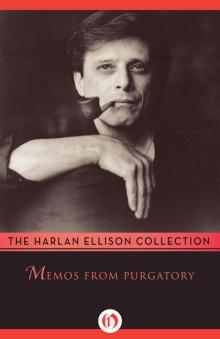 Memos From Purgatory
Memos From Purgatory I Have No Mouth and I Must Scream
I Have No Mouth and I Must Scream The Deadly Streets
The Deadly Streets The Glass Teat
The Glass Teat Paingod and Other Delusions
Paingod and Other Delusions No Doors No Windows
No Doors No Windows Strange Wine
Strange Wine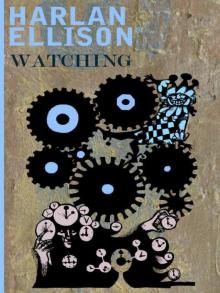 Harlan Ellison's Watching
Harlan Ellison's Watching Over the Edge/An Edge in My Voice
Over the Edge/An Edge in My Voice Troublemakers: Stories by Harlan Ellison
Troublemakers: Stories by Harlan Ellison Gentleman Junkie and Other Stories of the Hung-Up Generation
Gentleman Junkie and Other Stories of the Hung-Up Generation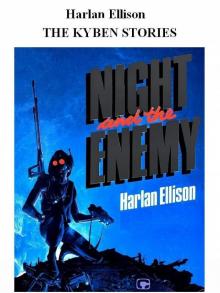 The Kyben Stories
The Kyben Stories From the Land of Fear
From the Land of Fear The Top of the Volcano: The Award-Winning Stories of Harlan Ellison
The Top of the Volcano: The Award-Winning Stories of Harlan Ellison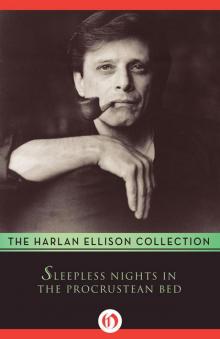 Sleepless Nights in the Procrustean Bed
Sleepless Nights in the Procrustean Bed Ellison Wonderland
Ellison Wonderland Children of the Streets
Children of the Streets Can & Can'tankerous
Can & Can'tankerous Love Ain't Nothing but Sex Misspelled
Love Ain't Nothing but Sex Misspelled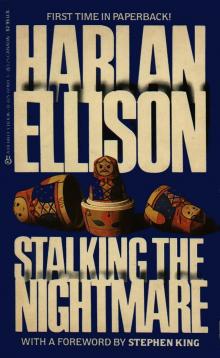 Stalking the Nightmare
Stalking the Nightmare Approaching Oblivion
Approaching Oblivion Deathbird Stories
Deathbird Stories Partners in Wonder
Partners in Wonder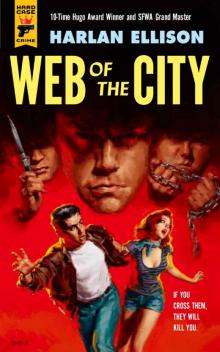 Web of the City
Web of the City Spider Kiss
Spider Kiss A Boy and His Dog
A Boy and His Dog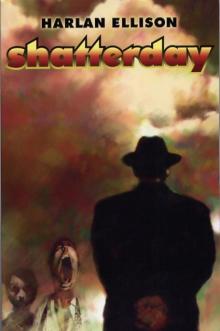 Shatterday
Shatterday Slippage: Previously Uncollected, Precariously Poised Stories
Slippage: Previously Uncollected, Precariously Poised Stories Repent, Harlequin! Said the Ticktockman
Repent, Harlequin! Said the Ticktockman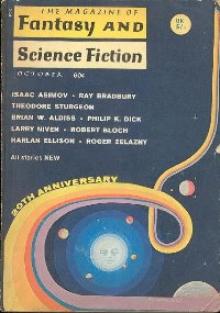 Come to Me Not in Winter's White
Come to Me Not in Winter's White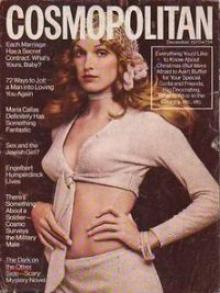 The Song the Zombie Sang
The Song the Zombie Sang The Other Glass Teat
The Other Glass Teat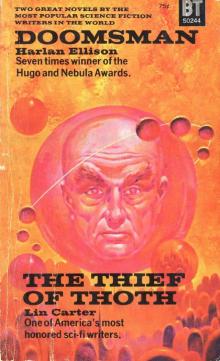 Doomsman - the Theif of Thoth
Doomsman - the Theif of Thoth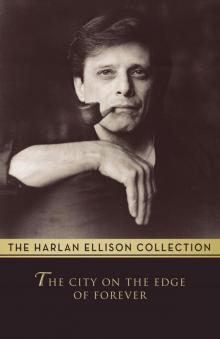 The City on the Edge of Forever
The City on the Edge of Forever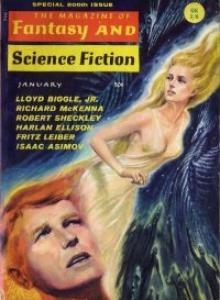 I See a Man Sitting on a Chair, and the Chair Is Biting His Leg
I See a Man Sitting on a Chair, and the Chair Is Biting His Leg The Harlan Ellison Hornbook
The Harlan Ellison Hornbook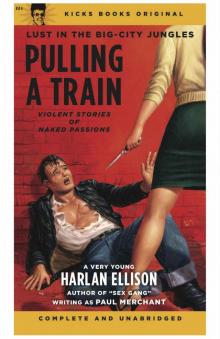 Pulling A Train
Pulling A Train The Glass Teat - essays of opinion on the subject of television
The Glass Teat - essays of opinion on the subject of television An Edge in My Voice
An Edge in My Voice Angry Candy
Angry Candy Troublemakers
Troublemakers The Top of the Volcano
The Top of the Volcano Over the Edge
Over the Edge Survivor #1
Survivor #1 Slippage
Slippage